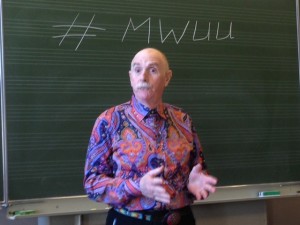There has been an eerie silence on this blog for the past weeks. I was immersed in various learning projects. I had to focus for longer times, and this made me switch my attention away from social media streams, unless I could focus on certain topics via Twitter lists for instance.
–  So what is the learning about? I’m still absorbing stuff I learned at the various courses facilitated by Howard Rheingold (there’s a new one coming up about Mind Amplifiers). Also, I attended a real life class featuring Howard in the Netherlands (more about this in a later post, but that’s where I took the picture), where he discussed the major findings of his book Net Smart (which can be considered as a long and deep study of attention practices). In this part of the learning it’s all about forums, blogs, wikis, mindmaps, social bookmarks, synchronous audio, video, chat and Twitter.
So what is the learning about? I’m still absorbing stuff I learned at the various courses facilitated by Howard Rheingold (there’s a new one coming up about Mind Amplifiers). Also, I attended a real life class featuring Howard in the Netherlands (more about this in a later post, but that’s where I took the picture), where he discussed the major findings of his book Net Smart (which can be considered as a long and deep study of attention practices). In this part of the learning it’s all about forums, blogs, wikis, mindmaps, social bookmarks, synchronous audio, video, chat and Twitter.
– The other part of my learning is about tools for digital stortytelling and data journalism. I made a good start on Codeacademy, but somehow I need the intervention of real tutors to continue the learning process. So I decided to take courses at the O’Reilly School of Technology. They even deliver certificates for professional developments. I do realize it are not the certificates which are that important, but it’s a kind of an interesting gamification element. The ‘school’ offers a nice interactive coding environment and tutors evaluate the homework and give feedback.
Crucial technologies I want to master: the components of HTML5 (HTML, CSS, JavaScript), jQuery, and for stuff such as web scraping I need a language such as Python.
Data Journalism is something we’re learning at our media company, and our teacher is Peter Verweij (who was so kind as to include the very basics of using spreadsheets in his program).
– Finally there is a big experiment of helping a newsroom to adapt to the age of never-ending social media streams, community interaction and digital storytelling.
Frankly, all this is pretty exhausting – but at least it forces me to focus for longer periods of time on the same subjects. In this sense it’s immersive – when one is trying to meet some Python course objective, times passes very fast – it’s like playing in some 3D environment.
Is something changing?
These last few years I got the impression we were evolving from longer, immersive experiences to sequences of fast dipping in and out of media streams (status updates, tweets etc). In that context I was not surprised an immersive envrionment such as Second Life was stagnating. It quite simply takes too much time and our attention spans were getting too short for this.
But think again. Maybe we once again want something more. People start complaining about the ‘Facebook-experience’. They start reading books such as Net Smart or meditate about mindfulness. But there’s also something going on at the technology-side of things.
 Philip Rosedale (archive picture), the founding father of Second Life, has a new company, High Fidelity, to create a new kind of virtual reality platform. True Ventures invested in the company. It’s about a new virtual world enabling rich avatar interactions driven by sensor-equipped hardware, simulated and served by devices (phones, tablets and laptops/desktops) contributed by end-users. Virtual worlds watcher Wagner James Au on New World Notes says that Rosedale is not alone: others are working hard to create new virtual reality platforms: “Overall, this feels like a real trend, made possible by continued leaps in computer power, especially related to 3D graphics, and their continued drop in price.”
Philip Rosedale (archive picture), the founding father of Second Life, has a new company, High Fidelity, to create a new kind of virtual reality platform. True Ventures invested in the company. It’s about a new virtual world enabling rich avatar interactions driven by sensor-equipped hardware, simulated and served by devices (phones, tablets and laptops/desktops) contributed by end-users. Virtual worlds watcher Wagner James Au on New World Notes says that Rosedale is not alone: others are working hard to create new virtual reality platforms: “Overall, this feels like a real trend, made possible by continued leaps in computer power, especially related to 3D graphics, and their continued drop in price.”
But maybe this new trend is also driven by the need of balancing the short attention bursts by longer periods of mindful attention…
Read also:Â
True Ventures about the investment in High Fidelity.

